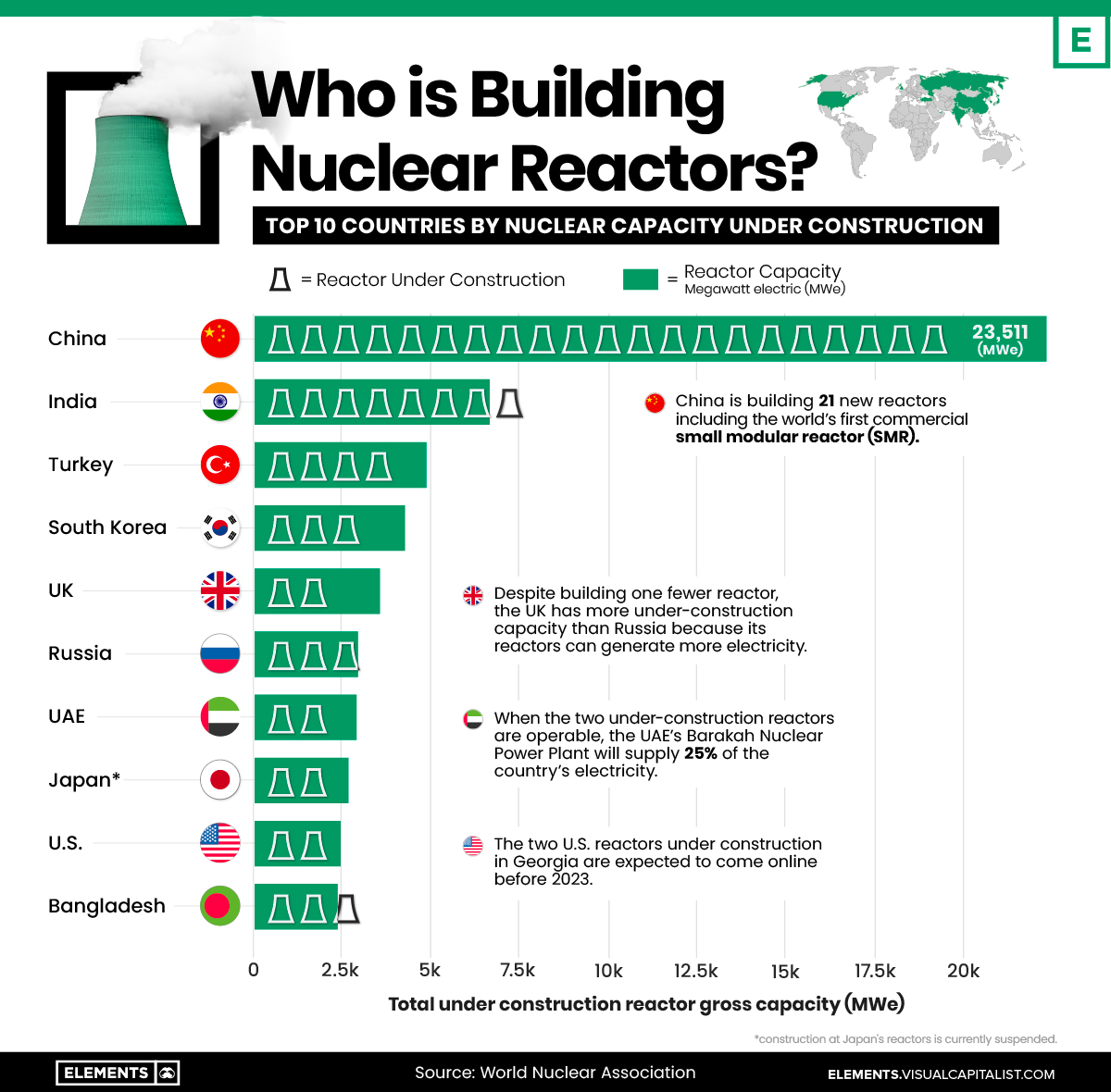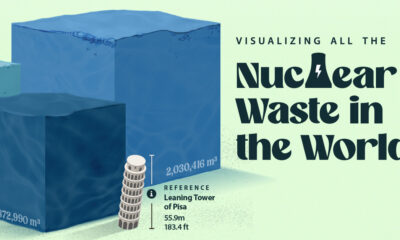Energy Shift
Who Is Building Nuclear Reactors?

Who Is Building Nuclear Reactors?
Nuclear power is back in the spotlight as countries look to supplement renewable energy sources with a reliable and clean source of power.
The 2010s were a decade of decline for nuclear power in the wake of the Fukushima disaster in Japan. However, the recent push for clean energy is reviving the industry with several countries building new reactors, and others restarting or extending old ones.
The above infographic uses data from the World Nuclear Association to show the top 10 countries by nuclear capacity under construction as of July 2022.
How Many Nuclear Reactors Are In the World?
Before looking at under-construction figures, it’s important to contextualize the current nuclear reactor landscape.
There are roughly 440 nuclear reactors operating worldwide, generating around 10% of the world’s electricity annually.
| Country | Number of operable reactors | Net capacity (MWe) |
|---|---|---|
| U.S. 🇺🇸 | 93 | 95,523 |
| France 🇫🇷 | 56 | 61,370 |
| China 🇨🇳 | 53 | 50,034 |
| Russia 🇷🇺 | 37 | 27,727 |
| Japan* 🇯🇵 | 33 | 31,679 |
| South Korea 🇰🇷 | 24 | 23,091 |
| India 🇮🇳 | 22 | 6,795 |
| Canada 🇨🇦 | 19 | 13,624 |
| Ukraine 🇺🇦 | 15 | 13,107 |
| UK 🇬🇧 | 12 | 7,343 |
*Only 10 of Japan’s 33 operable reactors are currently operating.
In the U.S., 93 reactors generate more than 30% of the world’s nuclear power, more than any other nation. In France, nuclear plants are the main source of power, accounting for 70% of annual electricity generation.
China’s nuclear industry has expanded rapidly over the last decade. The number of reactors in China jumped from 13 in 2010 to 53 in 2021, accompanied by a roughly five-fold increase in nuclear generation capacity.
India is an outlier—its generation capacity is lesser than the UK despite having 10 more operating reactors. This is largely because 17 of India’s 22 reactors have less than 300 MWe of capacity and are considered “small”.
Overall, around 280 of the world’s 440 reactors are over 30 years old. While these reactors are still performing at high capacity, new reactors are being built to support the aging fleet.
The Top 10 Countries Building New Reactors
The majority of new nuclear reactors are being built in Asia, with China topping the list followed by India.
| Country | Number of reactors under construction | Gross Capacity Under Construction, MWe |
|---|---|---|
| China 🇨🇳 | 21 | 23,511 |
| India 🇮🇳 | 8 | 6,600 |
| Turkey 🇹🇷 | 4 | 4,800 |
| South Korea 🇰🇷 | 3 | 4,200 |
| Russia 🇷🇺 | 3 | 2,810 |
| UK 🇬🇧 | 2 | 3,440 |
| UAE 🇦🇪 | 2 | 2,800 |
| Japan* 🇯🇵 | 2 | 2,653 |
| U.S. 🇺🇸 | 2 | 2,500 |
| Bangladesh 🇧🇩 | 2 | 2,400 |
| Ukraine* 🇺🇦 | 2 | 2,178 |
| Slovakia 🇸🇰 | 2 | 942 |
| France 🇫🇷 | 1 | 1,650 |
| Brazil* 🇧🇷 | 1 | 1,405 |
| Egypt 🇪🇬 | 1 | 1,200 |
| Belarus 🇧🇾 | 1 | 1,194 |
| Iran 🇮🇷 | 1 | 1,057 |
| Argentina 🇦🇷 | 1 | 29 |
| Total | 59 | 65,369 |
*Reactor construction is currently suspended in Japan, Ukraine, and Brazil.
China’s reliance on nuclear power is increasing as the economy transitions away from coal. With 21 reactors under construction, the country is set to expand its nuclear capacity by more than 40% before 2030. It’s also building the world’s first commercial small modular reactor (SMR), which will have the capacity to power more than 500,000 households annually.
Following China from afar is India, with eight reactors under construction that nearly double its generation capacity. While all reactors today are powered by uranium, India has an ambitious plan to develop a thorium-fueled reactor to reap its vast resources of thorium, a non-fissile radioactive material with the potential to be used as nuclear fuel.
Overall, the Asian continent (ex-Russia) accounts for 36 of the 59 reactors under construction. Meanwhile, Turkey is building four reactors including its first operational reactor, which is expected to come online in 2023.
As of July 2022, the largest under-construction reactors are in the UK with gross capacities of 1,720 MWe each. However, this may change as new constructions start with hundreds of reactors planned for construction across the globe.
Energy Shift
The World’s Biggest Oil Producers in 2023
Just three countries accounted for 40% of global oil production last year.

The World’s Biggest Oil Producers in 2023
This was originally posted on our Voronoi app. Download the app for free on iOS or Android and discover incredible data-driven charts from a variety of trusted sources.
Despite efforts to decarbonize the global economy, oil still remains one of the world’s most important resources. It’s also produced by a fairly limited group of countries, which can be a source of economic and political leverage.
This graphic illustrates global crude oil production in 2023, measured in million barrels per day, sourced from the U.S. Energy Information Administration (EIA).
Three Countries Account for 40% of Global Oil Production
In 2023, the United States, Russia, and Saudi Arabia collectively contributed 32.7 million barrels per day to global oil production.
| Oil Production 2023 | Million barrels per day |
|---|---|
| 🇺🇸 U.S. | 12.9 |
| 🇷🇺 Russia | 10.1 |
| 🇸🇦 Saudi Arabia | 9.7 |
| 🇨🇦 Canada | 4.6 |
| 🇮🇶 Iraq | 4.3 |
| 🇨🇳 China | 4.2 |
| 🇮🇷 Iran | 3.6 |
| 🇧🇷 Brazil | 3.4 |
| 🇦🇪 UAE | 3.4 |
| 🇰🇼 Kuwait | 2.7 |
| 🌍 Other | 22.8 |
These three nations have consistently dominated oil production since 1971. The leading position, however, has alternated among them over the past five decades.
In contrast, the combined production of the next three largest producers—Canada, Iraq, and China—reached 13.1 million barrels per day in 2023, just surpassing the production of the United States alone.
In the near term, no country is likely to surpass the record production achieved by the U.S. in 2023, as no other producer has ever reached a daily capacity of 13.0 million barrels. Recently, Saudi Arabia’s state-owned Saudi Aramco scrapped plans to increase production capacity to 13.0 million barrels per day by 2027.
In 2024, analysts forecast that the U.S. will maintain its position as the top oil producer. In fact, according to Macquarie Group, U.S. oil production is expected to achieve a record pace of about 14 million barrels per day by the end of the year.
Energy Shift
How Much Does the U.S. Depend on Russian Uranium?
Despite a new uranium ban being discussed in Congress, the U.S. is still heavily dependent on Russian uranium.

How Much Does the U.S. Depend on Russian Uranium?
This was originally posted on our Voronoi app. Download the app for free on iOS or Android and discover incredible data-driven charts from a variety of trusted sources.
The U.S. House of Representatives recently passed a ban on imports of Russian uranium. The bill must pass the Senate before becoming law.
In this graphic, we visualize how much the U.S. relies on Russian uranium, based on data from the United States Energy Information Administration (EIA).
U.S. Suppliers of Enriched Uranium
After Russia invaded Ukraine, the U.S. imposed sanctions on Russian-produced oil and gas—yet Russian-enriched uranium is still being imported.
Currently, Russia is the largest foreign supplier of nuclear power fuel to the United States. In 2022, Russia supplied almost a quarter of the enriched uranium used to fuel America’s fleet of more than 90 commercial reactors.
| Country of enrichment service | SWU* | % |
|---|---|---|
| 🇺🇸 United States | 3,876 | 27.34% |
| 🇷🇺 Russia | 3,409 | 24.04% |
| 🇩🇪 Germany | 1,763 | 12.40% |
| 🇬🇧 United Kingdom | 1,593 | 11.23% |
| 🇳🇱 Netherlands | 1,303 | 9.20% |
| Other | 2,232 | 15.79% |
| Total | 14,176 | 100% |
SWU stands for “Separative Work Unit” in the uranium industry. It is a measure of the amount of work required to separate isotopes of uranium during the enrichment process. Source: U.S. Energy Information Administration
Most of the remaining uranium is imported from European countries, while another portion is produced by a British-Dutch-German consortium operating in the United States called Urenco.
Similarly, nearly a dozen countries around the world depend on Russia for more than half of their enriched uranium—and many of them are NATO-allied members and allies of Ukraine.
In 2023 alone, the U.S. nuclear industry paid over $800 million to Russia’s state-owned nuclear energy corporation, Rosatom, and its fuel subsidiaries.
It is important to note that 19% of electricity in the U.S. is powered by nuclear plants.
The dependency on Russian fuels dates back to the 1990s when the United States turned away from its own enrichment capabilities in favor of using down-blended stocks of Soviet-era weapons-grade uranium.
As part of the new uranium-ban bill, the Biden administration plans to allocate $2.2 billion for the expansion of uranium enrichment facilities in the United States.
-

 Electrification3 years ago
Electrification3 years agoRanked: The Top 10 EV Battery Manufacturers
-

 Electrification2 years ago
Electrification2 years agoThe Key Minerals in an EV Battery
-

 Real Assets3 years ago
Real Assets3 years agoThe World’s Top 10 Gold Mining Companies
-

 Misc3 years ago
Misc3 years agoAll the Metals We Mined in One Visualization
-

 Electrification3 years ago
Electrification3 years agoThe Biggest Mining Companies in the World in 2021
-

 Energy Shift2 years ago
Energy Shift2 years agoWhat Are the Five Major Types of Renewable Energy?
-

 Electrification2 years ago
Electrification2 years agoMapped: Solar Power by Country in 2021
-

 Electrification2 years ago
Electrification2 years agoThe World’s Largest Nickel Mining Companies



















